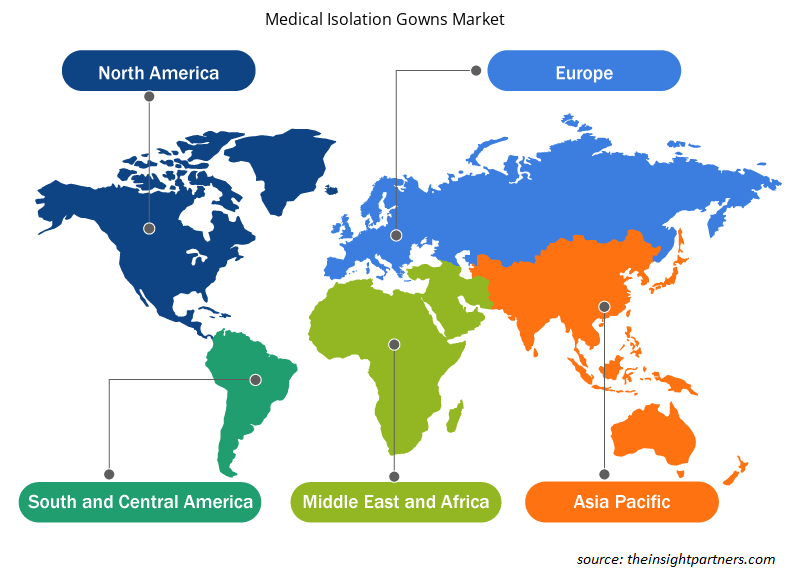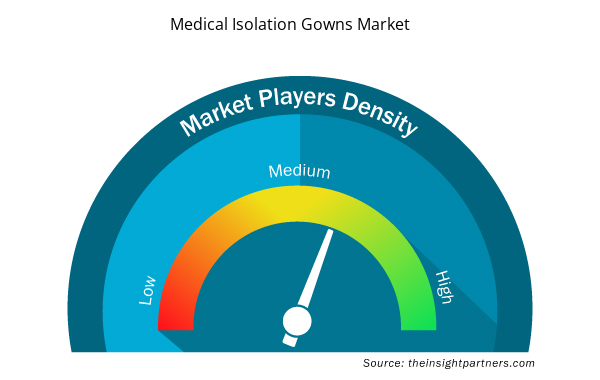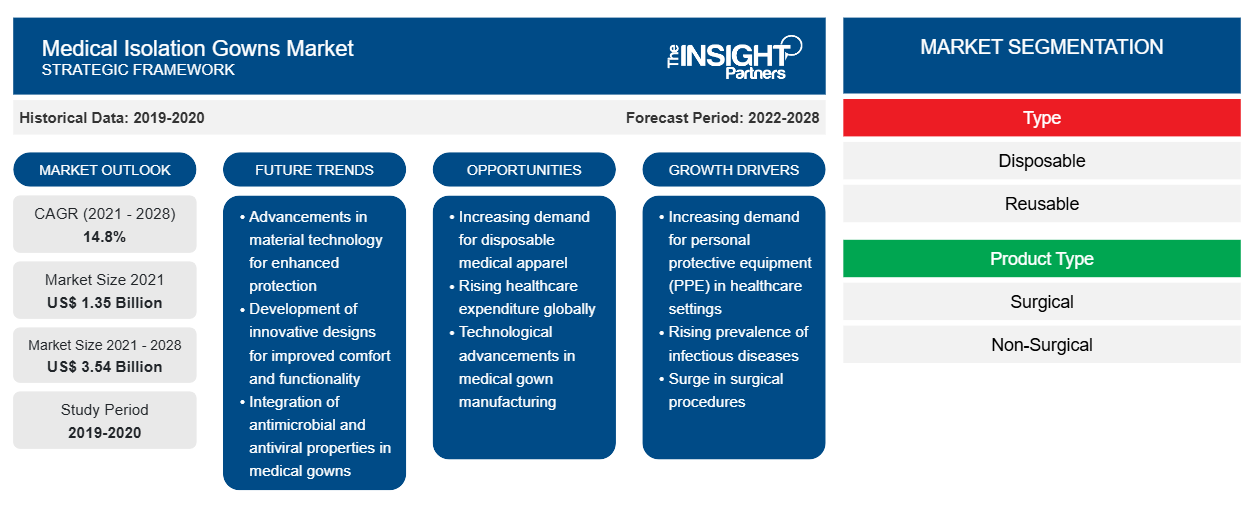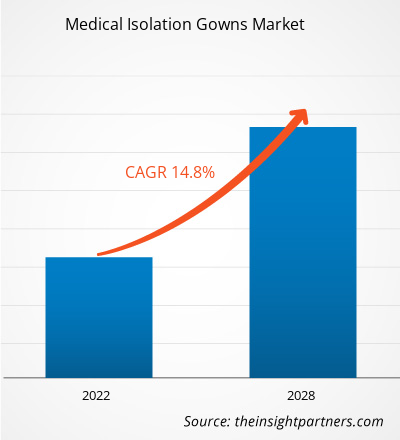Le marché des blouses d'isolement médical devrait atteindre 3 542,78 millions USD d'ici 2028, contre 1 346,31 millions USD en 2021 ; il devrait croître à un TCAC de 14,8 % de 2021 à 2028.
Le rapport offre des informations et une analyse approfondie du marché des blouses d'isolement médical en mettant l'accent sur divers paramètres, tels que les tendances et les opportunités du marché, la dynamique du marché et l'analyse du paysage concurrentiel des principaux acteurs du marché en Amérique du Nord, en Europe, en Asie-Pacifique, en Amérique du Sud et centrale et au Moyen-Orient et en Afrique. Il comprend également l'analyse de l'impact de la pandémie de COVID-19 dans les régions.
Personnalisez ce rapport en fonction de vos besoins
Vous bénéficierez d'une personnalisation gratuite de n'importe quel rapport, y compris de certaines parties de ce rapport, d'une analyse au niveau des pays, d'un pack de données Excel, ainsi que de superbes offres et réductions pour les start-ups et les universités.
- Obtenez les principales tendances clés du marché de ce rapport.Cet échantillon GRATUIT comprendra une analyse de données, allant des tendances du marché aux estimations et prévisions.
Informations sur le marché
Sensibilisation accrue aux infections contractées à l’hôpital
Les patients contractent des infections nosocomiales ou infections associées aux soins (IAS) lorsqu'ils reçoivent des services de santé dans un hôpital ou tout autre établissement de santé. Des agents pathogènes courants, tels que des bactéries, des virus, des champignons et des parasites, sont à l'origine de ces infections. Les IAS comprennent les infections urinaires associées aux cathéters, les infections du site chirurgical (ISO), les infections sanguines associées aux cathéters centraux, la pneumonie associée au respirateur, la pneumonie nosocomiale et plusieurs autres infections. De nombreux dispositifs chirurgicaux peuvent également servir de vecteurs d'IAS.
Les infections nosocomiales ont un taux de morbidité et de mortalité élevé et coûtent des milliards de dollars au système de santé chaque année. Les Centers for Disease Control (CDC) ont signalé que les infections nosocomiales sont responsables d'environ 1,7 million de cas d'infection et de 99 000 décès chaque année dans les hôpitaux américains. Le port de blouses d'isolement est obligatoire lors de toute procédure médicale dans les établissements de santé. Elles aident à prévenir la contamination croisée, le transfert de liquides corporels et tout micro-organisme responsable d'infections ainsi que la pénétration de liquides. Les agences gouvernementales, telles que le National Healthcare Safety Network (NHSN) du Center for Disease Control and Prevention (CDC), surveillent de près les infections qui aident à prévenir les infections nosocomiales et à améliorer la sécurité des patients. Aux États-Unis, le ministère de la Santé et des Services sociaux (HHS) s'efforce de réduire les cas d'infections nosocomiales. De plus, en Europe, le Healthcare-Associated Infections Surveillance Network (HAI-Net) surveille ces infections dans la région, et le fonctionnement du HAI-NET est géré et contrôlé par le Centre européen de prévention et de contrôle des maladies (ECDC). Par exemple, une enquête intitulée « Sensibilisation aux IASS parmi les étudiants en médecine dans un centre de soins tertiaires » a révélé qu’un total de 82 % (sur 250) des étudiants étaient conscients des IASS.
Informations basées sur les types
En fonction du type, le marché des blouses d'isolement médical est divisé en jetables et réutilisables. Le segment jetable détenait une part plus importante du marché en 2021. Cependant, le segment réutilisable devrait enregistrer un TCAC plus élevé de 15,5 % sur le marché au cours de la période de prévision.
Informations basées sur le type de produit
En fonction du type de produit, le marché des blouses d'isolement médical est divisé en deux catégories : chirurgicales et non chirurgicales. Le segment chirurgical détenait une part de marché plus importante en 2021. Cependant, le segment non chirurgical devrait enregistrer un TCAC plus élevé de 15,1 % au cours de la période de prévision.
Les stratégies inorganiques, telles que les fusions et acquisitions, sont couramment adoptées par les entreprises pour répondre aux demandes changeantes des clients et maintenir leur marque à travers le monde. Les acteurs opérant sur le marché des blouses d'isolement médical adoptent également des stratégies organiques, telles que le lancement et l'expansion de produits, pour étendre leur empreinte et leur portefeuille de produits dans le monde entier ainsi que pour répondre à la demande croissante.
Aperçu régional du marché des blouses d'isolement médicales
Les tendances et facteurs régionaux influençant le marché des blouses d’isolement médicales tout au long de la période de prévision ont été expliqués en détail par les analystes d’Insight Partners. Cette section traite également des segments et de la géographie du marché des blouses d’isolement médicales en Amérique du Nord, en Europe, en Asie-Pacifique, au Moyen-Orient et en Afrique, ainsi qu’en Amérique du Sud et en Amérique centrale.

- Obtenez les données régionales spécifiques au marché des blouses d'isolement médicales
Portée du rapport sur le marché des blouses d'isolement médicales
| Attribut de rapport | Détails |
|---|---|
| Taille du marché en 2021 | 1,35 milliard de dollars américains |
| Taille du marché d'ici 2028 | 3,54 milliards de dollars américains |
| Taux de croissance annuel moyen mondial (2021-2028) | 14,8% |
| Données historiques | 2019-2020 |
| Période de prévision | 2022-2028 |
| Segments couverts | Par type
|
| Régions et pays couverts | Amérique du Nord
|
| Leaders du marché et profils d'entreprises clés |
|
Densité des acteurs du marché des blouses d'isolement médical : comprendre son impact sur la dynamique commerciale
Le marché des blouses d'isolement médicales connaît une croissance rapide, tirée par la demande croissante des utilisateurs finaux en raison de facteurs tels que l'évolution des préférences des consommateurs, les avancées technologiques et une plus grande sensibilisation aux avantages du produit. À mesure que la demande augmente, les entreprises élargissent leurs offres, innovent pour répondre aux besoins des consommateurs et capitalisent sur les tendances émergentes, ce qui alimente davantage la croissance du marché.
La densité des acteurs du marché fait référence à la répartition des entreprises ou des sociétés opérant sur un marché ou un secteur particulier. Elle indique le nombre de concurrents (acteurs du marché) présents sur un marché donné par rapport à sa taille ou à sa valeur marchande totale.
Les principales entreprises opérant sur le marché des blouses d'isolement médicales sont :
- Cardinal Santé, Inc.
- Medline Industries, Inc.
- Produits de santé Leboo Limitée
- Narang Médical Limitée
- Société médicale de Shanghai
Avis de non-responsabilité : les sociétés répertoriées ci-dessus ne sont pas classées dans un ordre particulier.

- Obtenez un aperçu des principaux acteurs du marché des blouses d'isolement médicales
Par type
- Jetable
- Réutilisable
Par type de produit
- Chirurgical
- Non chirurgical
Par utilisateur final
- Hôpitaux
- Centres de chirurgie ambulatoire
- Cliniques
- Autres
Par géographie
- Amérique du Nord
- NOUS
- Canada
- Mexique
- Europe
- Serbie
- ROYAUME-UNI
- Russie
- Pologne
- Estonie
- Lituanie
- Suède
- Slovaquie
- Finlande
- Allemagne
- France
- Italie
- Espagne
- Reste de l'Europe
- Asie-Pacifique
- Chine
- Japon
- Inde
- Australie
- Corée du Sud
- Reste de l'Asie-Pacifique
- Moyen-Orient et Afrique
- Émirats arabes unis
- Arabie Saoudite
- Afrique
- Reste du Moyen-Orient et de l'Afrique
- Amérique du Sud et Amérique centrale
- Brésil
- Argentine
- Reste de l'Amérique du Sud et de l'Amérique centrale
Profils d'entreprise
- Analyse historique (2 ans), année de base, prévision (7 ans) avec TCAC
- Analyse PEST et SWO
- Taille du marché Valeur / Volume - Mondial, Régional, Pays
- Industrie et paysage concurrentiel
- Ensemble de données Excel



Report Coverage
Revenue forecast, Company Analysis, Industry landscape, Growth factors, and Trends

Segment Covered
This text is related
to segments covered.

Regional Scope
North America, Europe, Asia Pacific, Middle East & Africa, South & Central America

Country Scope
This text is related
to country scope.
Questions fréquemment posées
The market is estimated to grow with a CAGR of 14.9% from 2021 to 2028.
Cardinal Health, Inc.; Medline Industries, Inc.; Leboo Healthcare Products Limited; Shanghai Medical Corporation; Mölnlycke Health Care AB; Advin Healthcare; Dispotech SRL; CWS International GmbH; Elis SA (Elis); and Alsco, Inc. are among the leading companies operating in the high throughput screening market.
Key factors that are driving growth of the market are increasing awareness regarding hospital-acquired infections and increase in number of emergency procedures in the medical isolation gowns market fuel the growth of the market.
Isolation gowns are a kind of personal protective equipment used in health care facilities. They are designed to help protect the front-line caregivers and other personnel from infectious droplets, fluid penetration, and solid materials and prevent the transmission of micro-organisms to people with weak immune systems. Medical gowns are a part of the infection-control strategy. The medical isolation gowns are categorized into four levels, such as level 1, level 2, level 3, and level 4. Level 1 gown is to be used during minimal risk conditions, level 2 gowns for low risk, level 3 gowns during moderate risk such as in the Emergency Room or for trauma cases, and level 4 gowns during high-risk conditions where pathogen resistance is required.
Trends and growth analysis reports related to Life Sciences : READ MORE..
The Insight Partners performs research in 4 major stages: Data Collection & Secondary Research, Primary Research, Data Analysis and Data Triangulation & Final Review.
- Data Collection and Secondary Research:
As a market research and consulting firm operating from a decade, we have published and advised several client across the globe. First step for any study will start with an assessment of currently available data and insights from existing reports. Further, historical and current market information is collected from Investor Presentations, Annual Reports, SEC Filings, etc., and other information related to company’s performance and market positioning are gathered from Paid Databases (Factiva, Hoovers, and Reuters) and various other publications available in public domain.
Several associations trade associates, technical forums, institutes, societies and organization are accessed to gain technical as well as market related insights through their publications such as research papers, blogs and press releases related to the studies are referred to get cues about the market. Further, white papers, journals, magazines, and other news articles published in last 3 years are scrutinized and analyzed to understand the current market trends.
- Primary Research:
The primarily interview analysis comprise of data obtained from industry participants interview and answers to survey questions gathered by in-house primary team.
For primary research, interviews are conducted with industry experts/CEOs/Marketing Managers/VPs/Subject Matter Experts from both demand and supply side to get a 360-degree view of the market. The primary team conducts several interviews based on the complexity of the markets to understand the various market trends and dynamics which makes research more credible and precise.
A typical research interview fulfils the following functions:
- Provides first-hand information on the market size, market trends, growth trends, competitive landscape, and outlook
- Validates and strengthens in-house secondary research findings
- Develops the analysis team’s expertise and market understanding
Primary research involves email interactions and telephone interviews for each market, category, segment, and sub-segment across geographies. The participants who typically take part in such a process include, but are not limited to:
- Industry participants: VPs, business development managers, market intelligence managers and national sales managers
- Outside experts: Valuation experts, research analysts and key opinion leaders specializing in the electronics and semiconductor industry.
Below is the breakup of our primary respondents by company, designation, and region:

Once we receive the confirmation from primary research sources or primary respondents, we finalize the base year market estimation and forecast the data as per the macroeconomic and microeconomic factors assessed during data collection.
- Data Analysis:
Once data is validated through both secondary as well as primary respondents, we finalize the market estimations by hypothesis formulation and factor analysis at regional and country level.
- Macro-Economic Factor Analysis:
We analyse macroeconomic indicators such the gross domestic product (GDP), increase in the demand for goods and services across industries, technological advancement, regional economic growth, governmental policies, the influence of COVID-19, PEST analysis, and other aspects. This analysis aids in setting benchmarks for various nations/regions and approximating market splits. Additionally, the general trend of the aforementioned components aid in determining the market's development possibilities.
- Country Level Data:
Various factors that are especially aligned to the country are taken into account to determine the market size for a certain area and country, including the presence of vendors, such as headquarters and offices, the country's GDP, demand patterns, and industry growth. To comprehend the market dynamics for the nation, a number of growth variables, inhibitors, application areas, and current market trends are researched. The aforementioned elements aid in determining the country's overall market's growth potential.
- Company Profile:
The “Table of Contents” is formulated by listing and analyzing more than 25 - 30 companies operating in the market ecosystem across geographies. However, we profile only 10 companies as a standard practice in our syndicate reports. These 10 companies comprise leading, emerging, and regional players. Nonetheless, our analysis is not restricted to the 10 listed companies, we also analyze other companies present in the market to develop a holistic view and understand the prevailing trends. The “Company Profiles” section in the report covers key facts, business description, products & services, financial information, SWOT analysis, and key developments. The financial information presented is extracted from the annual reports and official documents of the publicly listed companies. Upon collecting the information for the sections of respective companies, we verify them via various primary sources and then compile the data in respective company profiles. The company level information helps us in deriving the base number as well as in forecasting the market size.
- Developing Base Number:
Aggregation of sales statistics (2020-2022) and macro-economic factor, and other secondary and primary research insights are utilized to arrive at base number and related market shares for 2022. The data gaps are identified in this step and relevant market data is analyzed, collected from paid primary interviews or databases. On finalizing the base year market size, forecasts are developed on the basis of macro-economic, industry and market growth factors and company level analysis.
- Data Triangulation and Final Review:
The market findings and base year market size calculations are validated from supply as well as demand side. Demand side validations are based on macro-economic factor analysis and benchmarks for respective regions and countries. In case of supply side validations, revenues of major companies are estimated (in case not available) based on industry benchmark, approximate number of employees, product portfolio, and primary interviews revenues are gathered. Further revenue from target product/service segment is assessed to avoid overshooting of market statistics. In case of heavy deviations between supply and demand side values, all thes steps are repeated to achieve synchronization.
We follow an iterative model, wherein we share our research findings with Subject Matter Experts (SME’s) and Key Opinion Leaders (KOLs) until consensus view of the market is not formulated – this model negates any drastic deviation in the opinions of experts. Only validated and universally acceptable research findings are quoted in our reports.
We have important check points that we use to validate our research findings – which we call – data triangulation, where we validate the information, we generate from secondary sources with primary interviews and then we re-validate with our internal data bases and Subject matter experts. This comprehensive model enables us to deliver high quality, reliable data in shortest possible time.


 Obtenez un échantillon gratuit pour ce rapport
Obtenez un échantillon gratuit pour ce rapport